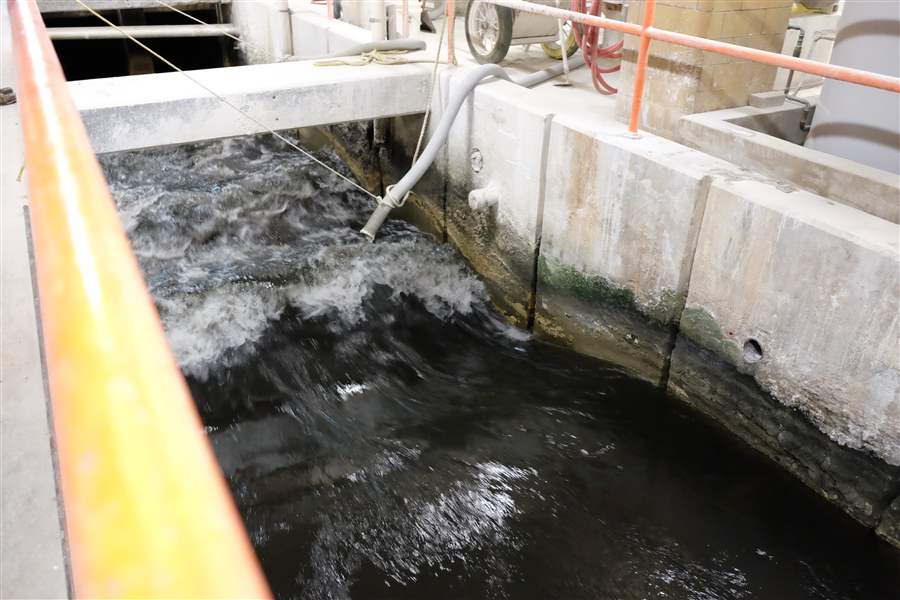
Last water distribution, treatment study done
Northwest Ohio communities to decide what system to use
9/12/2016
Lake Erie water makes its appearance in the Collins Park Water Treatment Plant in the Rapid mix room, where aluminum sulfate is added.
THE BLADE/JETTA FRASER
Buy This Image
The final of three area studies about water distribution and treatment has been released, and now northwest Ohio communities will decide whether to stay connected to Toledo’s system, build a regional system, or go out on their own.
The most recent study is from Wood County, and joins ones by Sylvania and the Toledo Metropolitan Area Council of Governments. The studies provide ammunition for those in Toledo’s suburbs who argue the city’s monopoly on water distribution has been to their detriment. No decisions have been made, and Toledo officials are hoping that a regional system, as mentioned in both the Sylvania and TMACOG evaluations, is developed.
“The City of Toledo is part of the TMACOG Regional Water Planning Committee,” Mayor Paula Hicks-Hudson said in a statement. “[Sylvania] Mayor [Craig] Stough, who chairs the committee, has publicly stated that the region is better off if we all work together as a region, and I am in total agreement with him.”
The Wood County study deals with Perrysburg and parts of the Northwestern Water and Sewer District, both of which purchase water from Toledo. While the study has no final conclusions or recommendations, it does state that hooking those two areas up to Bowling Green’s system and a corresponding expansion of that city’s water capacity has the best potential.
Commissioned by the Wood County Economic Development Commission and conducted by the Poggemeyer Design Group, the study was conducted because of rising water rates in the Toledo system and the 2014 water crisis, when algal toxins overwhelmed the Toledo plant.
“The water crisis brought national attention to this area of northwest Ohio and brought into question the impacts on future economic development attraction and retention efforts.
Three options are explored in the study: building an intake in the Maumee River, drawing water from Lake Erie at the Bayshore power plant, and purchasing water from Bowling Green.
Each plan has cost estimates of more than $230 million, with the most expensive being the Maumee River intake. But the study notes the plans could be cost effective for rate payers, especially the Bayshore and Bowling Green options.
Perrysburg users are projected to pay $28.35 per 7,500 gallons in 2024 with Toledo’s water, while users of the water-sewer district are projected to pay $58.47. The study estimates users in both areas would pay $23.42 under the Bowling Green plan, although that assumes United States Department of Agriculture grant money is secured. If not, users would pay $40.85 in both areas.
Northwestern Water and Sewer District President Jerry Greiner said he should know by late spring next year if the potential expansion would qualify for the grant, and he put the chance of success at 50 percent.
He also said the projected Toledo rates don’t account for additional expenditures to update the plant.
Bowling Green provides water to other areas, such as southern Wood County and Waterville left the Toledo system for Bowling Green. But an expansion would be needed to handle Perrysburg and the water district as new customers, and a new reservoir might be needed too.
It’s unclear if Bowling Green would want to add Perrysburg and the water-sewer district. Bowling Green Utilities Director Brian O’Connell said the city has been part of the regional water talks, but it hasn’t fully analyzed the Wood County study.
“I think we need to look at the study and see what the numbers show,” he said.
F, the idea makes some sense. The district purchases water from Bowling Green, Mr. Greiner said. And for communities such as his, Perrysburg, and Maumee, it’s unknown what Toledo’s rates will beorthwestern Water and Sewer Districtor the N.
The potential loss of suburban customers could have major consequences for the Toledo water system. The TMACOG study projected that the average monthly water rate for Toledoans would increase by $44.14 — roughly 198 percent — from $22.19 to $66.33 if the suburbs broke off and city residents were forced to maintain and upgrade the Collins Park Water Treatment Plant on their own.
Waterville has left, and Fulton County was on the verge too before securing a price break.The TMACOG study includes an option to have a regional water system with equal rates in Toledo and its suburbs.
Mr. Greiner agrees that a move away from Toledo’s water system would have adverse affects on remaining users, in particular Toledoans. Everyone in the system, including Toledo and the communities thinking of going out on their own, need to be frank about what their plans are.
“Everyone has to be honest and come clean,” he said.
Contact Nolan Rosenkrans at: nrosenkrans@theblade.com or 419-724-6086, or on Twitter @NolanRosenkrans.